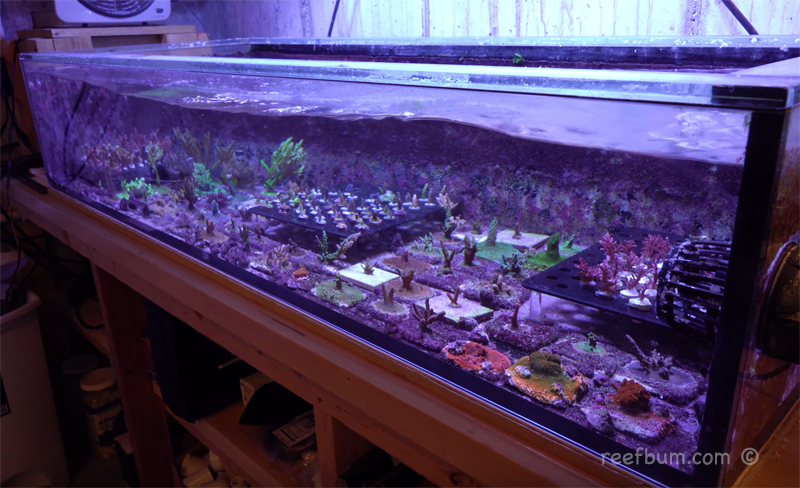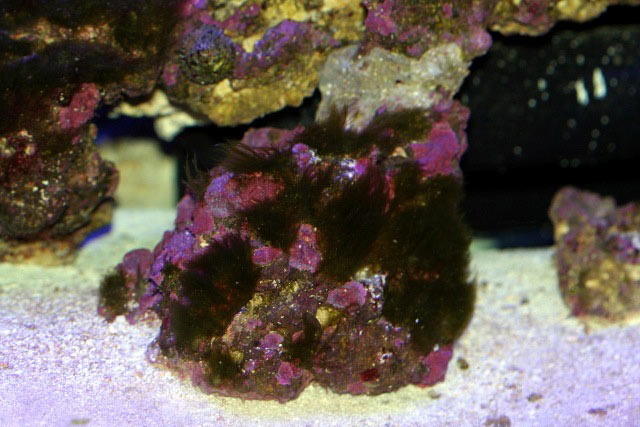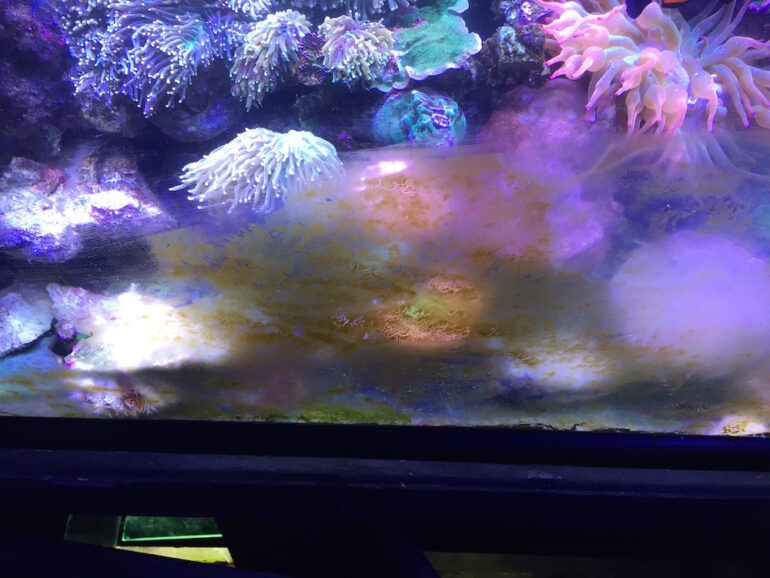Now moving on to its prevention lets find out the cause of these algae. Brown algae can be a delicious meal or an unsightly oxygen hog depending on the type of animal you choose to keep in your aquarium.
 The Benefits Of Algae In Saltwater Tanks Ratemyfishtank Com
The Benefits Of Algae In Saltwater Tanks Ratemyfishtank Com
Brown Diatom Algae is not an alga but a single-celled organism that appears in an aquarium when there is an abundance of Silicate.

Brown algae bloom in new marine tank. Marine diatoms are a common problem in a marine aquarium common solutions areCheck your lighting is the correct bulb brightness and on the correct amount o. Almost sure to appear in a new system diatoms are some of the most abundant organisms on earth. Its most common in reef tanks under six months old and it is algae kind of but it cant be solved the conventional way.
Brown algae patches can be removed from surfaces in the reef tank with a soft sponge. Brown algae can also take over the tank when the lighting is too high or too weak for the aquarium. What causes brown algae to appear in your tank.
Brown Algae are commonly seen on the corners of aquarium first and slowly it covers the aquarium wall substrates decorations and plants. Scrubbing away the brown algae. The presence of phytoplankton often results in a green discoloration of tank water though the color may also be red or yellowish brown depending on the species of algae.
Excess silica or nitrate in the water or an abundance of nutrients. 5 Try adding allelopathic plants. In most saltwater tanks cyanobacteria can be mistaken for brown algae.
It will usually appear in the first few months of setting up a reef aquarium. Brown algae can be a plague that ruins the look of a reef tank and can cause the owner to pull their hair out. To put it simply.
Identification of Brown Algae It is rusty brown in color and sometimes it can be of mustard color as well. Brown algae is a unicellular organism that is brown in color it has a bony structure that is primarily composed of silicon nitrate. Removing silicates RO water.
Ways of Getting Rid of Brown Algae in Saltwater Aquariums 1. If there are no more silicates left brown algae can also survive on nitrates in the water. Phytoplankton algae blooms are caused by an imbalance of organic materials within a fish tank.
The best way to tell the cyanobacteria apart from the diatoms is how easily it comes off the surface. Diatoms feed on available silicates in your system and will run their course in time. Bristle stars bristle worms aquatic hermit crabs Nassarius snails and sea cucumbers will all help control algae in a marine tank by removing organic detritus from the substrate of your tank.
The most common causes of green water are the overfeeding of fish and also fish waste in an overpopulated system. Time Nerite Snails Cerith Snails and Margarita Snails can all help to reduce Diatoms. Brown diatoms are often seen in new aquariums that have just completed their biological cycling process.
Brown Algae is also a sign that the water chemistry of your aquarium is not in optimal balance. The presence of Silicates in the reef tanks is the number one reason for the Brown. They usually surface in the aquarium as a brown powdery like substance within a week or so after a tank finishes its cycle.
The most common cause of algae blooms is an excess of nutrients in the tank particularly phosphorus though excess carbon and nitrogen can also cause algae blooms. Silicates are considered to be the number one cause of brown algae blooms. Some plants produce and release chemicals that can help inhibit algal growth in a home aquarium.
In general you can look at a few main causes. When aquarium owners talk about brown algae they are actually talking about diatoms microscopic brownish or greenish creatures with glassy skeletons. Brown diatom algae can be found in the oceans down to depths of about 600 feet so they wont have any problems finding enough light to multiply in your brightly lit reef tank which may be only 24 inches deep.
When you wipe or rub them only the part that you touch comes off. Brown algae develops in aquariums with high nitrates and sometimes those with high silicon levels. After providing proper lighting improving water quality should be your next concern.
Diatom algae sometimes also called brown algae are naturally occurring organisms that can occur in either freshwater or saltwater environments. Silicate in the water. Diatoms do not peel in sheets.
They can and do also inhabit rock or sand and can even live in the glass walls and floor of your aquarium which is frequently how they enter your tank environment in the first place.
 How To Eliminate And Prevent Diatoms In A Reef Tank Reefbum
How To Eliminate And Prevent Diatoms In A Reef Tank Reefbum
 How To Kill Diatoms Reef Tank Diatoms Diatoms Update Youtube
How To Kill Diatoms Reef Tank Diatoms Diatoms Update Youtube
 Aquarium Answers Pond Fish Question And Help Articles Aquarium Algae Control Brown Diatom Hair Marine Bba Green Spot W Aquarium Algae Aquarium Algae
Aquarium Answers Pond Fish Question And Help Articles Aquarium Algae Control Brown Diatom Hair Marine Bba Green Spot W Aquarium Algae Aquarium Algae
 Tracey Bloom On Instagram Haven T Seen Him Since I Put Him In The Tank Two Weeks Ago He Finally Made An Appearan Saltwater Tank Seahorse Tank Marine Aquarium
Tracey Bloom On Instagram Haven T Seen Him Since I Put Him In The Tank Two Weeks Ago He Finally Made An Appearan Saltwater Tank Seahorse Tank Marine Aquarium
 How To Kill Marine Aquarium Brown Algae Diatoms Youtube
How To Kill Marine Aquarium Brown Algae Diatoms Youtube
 Brown Cloudy Water Beginners Discussion Nano Reef Community
Brown Cloudy Water Beginners Discussion Nano Reef Community
 Green Hair Algae By Stephen Hopple Reefkeeping Com
Green Hair Algae By Stephen Hopple Reefkeeping Com
 8 Brilliant Home Aquarium Installations Saltwater Aquarium Fish Fish Tank Decorations Saltwater Aquarium
8 Brilliant Home Aquarium Installations Saltwater Aquarium Fish Fish Tank Decorations Saltwater Aquarium
Cycle Process And Stages Reef2reef Saltwater And Reef Aquarium Forum
 How To Remove Red Algae From Fish Tank Aquarium Care Youtube Fish Tank Algae Aquarium Algae
How To Remove Red Algae From Fish Tank Aquarium Care Youtube Fish Tank Algae Aquarium Algae
 How To Get Rid Of Brown Algae In A Reef Tank Swell Uk
How To Get Rid Of Brown Algae In A Reef Tank Swell Uk
 Cyano Blue Green Algae Google Search Aquarium Algae Aquascape Algae
Cyano Blue Green Algae Google Search Aquarium Algae Aquascape Algae
 Nuisance Algae Guide Reef Cleaners Nano Reef Community
Nuisance Algae Guide Reef Cleaners Nano Reef Community
How Long Does The Ugly Stage Last Reef2reef Saltwater And Reef Aquarium Forum
Brown Algae On My Sand Bed That Always Comes Back After Weekly Maintenance Reef2reef Saltwater And Reef Aquarium Forum
 Clean Gracilaria Curtissae Marine Algae From The Macroalgae Experts Marine Tank Sea Plants Red Grapes
Clean Gracilaria Curtissae Marine Algae From The Macroalgae Experts Marine Tank Sea Plants Red Grapes
 How To Get Rid Of Brown Diatom Algae Diatom How To Get Rid Aquarium Algae
How To Get Rid Of Brown Diatom Algae Diatom How To Get Rid Aquarium Algae
 Problematic Algae And How To Manage It Reef Builders The Reef And Saltwater Aquarium Blog
Problematic Algae And How To Manage It Reef Builders The Reef And Saltwater Aquarium Blog
